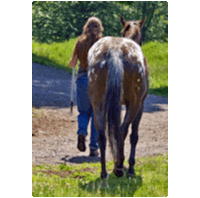

Through the Looking-Glass
a bug's-eye view of the equine gut and what it can tell us
about feeding horses
Dr Christine King
(book in process; scheduled for completion in 2024)
Chapter 1
"What's one and one and one and one and one
and one and one and one and one and one?"
"I don't know," said Alice. "I lost count."
Bibliography
In order of appearance:
Salter RE and Hudson RJ. Feeding ecology of feral horses in western Alberta. Journal of Range Management, 1979; 32: 221–225.
Abella SR. A systematic review of wild burro grazing effects on Mojave Desert vegetation, USA. Environmental Management, 2008; 41: 809–819.
Costa MC, Arroyo LG, Allen-Vercoe E, et al. Comparison of the fecal microbiota of healthy horses and horses with colitis by high throughput sequencing of the V3-V5 region of the 16S rRNA gene. PLoS [Public Library of Science] ONE, 2012; 7: e41484.
O'Donnell MM, Harris HMB, Jeffery IB, et al. The core faecal bacterial microbiome of Irish Thoroughbred racehorses. Letters in Applied Microbiology, 2013; 57: 492–501.
Fernandes KA, Kittelmann S, Rogers CW, et al. Faecal microbiota of forage-fed horses in New Zealand and the population dynamics of microbial communities following dietary change. PLoS [Public Library of Science] ONE, 2014; 9: e112846.
Sisson S. Equine digestive system. In: Sisson and Grossman's The Anatomy of the Domestic Animals, 5th edition, volume 1, Getty R (editor). W.B. Saunders Co., Philadelphia, PA, 1975; pages 477–488.
Smyth GB. Effects of age, sex, and post mortem interval on intestinal lengths of horses during development. Equine Veterinary Journal, 1988; 20: 104–108.
Pfeiffer CJ, MacPherson BR. Anatomy of the gastro-intestinal tract and peritoneal cavity. In: The Equine Acute Abdomen, White NA II (editor). Lea & Febiger, Malvern, PA, 1990; pages 2–24.
Lawrence LM, Cymbaluk NF, Freeman DW, et al. Energy Sources. In: Nutrient Requirements of Horses, 6th revised edition, Lawrence LM (chair), Committe on Nutrient Requirements of Horses, National Research Council of the National Academies. The National Academies Press, Washington, DC, 2007; page 6.
Mackie RI, Wilkins CA. Enumeration of anaerobic bacterial microflora of the equine gastrointestinal tract. Applied and Environmental Microbiology, 1988; 54: 2155–2160.
de Fombelle A, Jacotot E, Drogo ul C, et al. Effect of the hay:grain ratio on microbial and physico-chemical characteristics of cecal and colonic contents in ponies. Proceedings of the 16th Equine Nutrition and Physiology Symposium, Raleigh, NC, 1999; 16: 153–154.
de Fombelle A, Varloud M, Goachet A , et al. Characterization of the microbial and biochemical profile of the different segments of the digestive tract in horses given two distinct diets. Animal Science, 2003; 77: 293–304.
Milinovich GJ, Burrell PC, Pollitt CC, et al. Microbial ecology of the equine hindgut during oligofructose-induced laminitis. The ISME [International Society for Microbial Ecology] Journal, 2008; 2: 1089–1100.
Respondek F, Goachet AG, Julliand. Effects of dietary short-chain fructooligosaccharides on the intestinal microflora of horses subjected to a sudden change in diet. Journal of Animal Science, 2008; 86: 316–323.
Muhonen S, Julliand V, Lindberg JE, et al. Effects on the equine colon ecosystem of grass silage and haylage diets after an abrupt change from hay. Journal of Animal Science, 2009; 87: 2291–2298.
Lopes MA, White NA II, Crisman MV, et al. Effects of feeding large amounts of grain on colonic contents and feces in horses. American Journal of Veterinary Research, 2004; 65: 687–694.
Costa MC, Silva G, Ramos RV, et al. Characterization and comparison of the bacterial microbiota in different gastrointestinal tract compartments in horses. The Veterinary Journal, 2015; 205: 74–80.
Furet JP, Firmesse O, Gourmelon M, et al. Comparative assessment of human and farm animal faecal microbiota using real-time quantitative PCR. FEMS [Federation of European Microbiological Societies] Microbiology Ecology, 2009; 68: 351–362.
Williams S, Horner J, Orton M, et al. Water intake, faecal output and intestinal motility in horses moved from pasture to a stabled management regime with controlled exercise. Equine Veterinary Journal, 2015; 47: 96–100.
Ingham ER. Bacteria. In Soil Biology Primer [online] Tugel AJ, Lewandowski AM (editors). Last update: February 2001. https://extension.illinois.edu/soil/SoilBiology/bacteria.htm. Accessed on August 15, 2016.
Costa MC, Weese JS. The equine intestinal microbiome. Animal Health Research Reviews, 2012; 13: 121–128.
Hart ML, Meyer A, Johnson PJ, et al. Comparative evaluation of DNA extraction methods from feces of multiple host species for downstream next-generation sequencing. PLoS [Public Library of Science] ONE, 2015; 10: e0143334.
Shepherd ML, Swecker WS Jr, Jensen RV, et al. Characterization of the fecal bacteria communities of forage-fed horses by pyrosequencing of 16S rRNA V4 gene amplicons. FEMS [Federation of European Microbiological Societies] Microbiology Letters, 2012; 326: 62–68.
Costa MC, Stämpfli HR, Allen-Vercoe E, et al. Development of the faecal microbiota in foals. Equine Veterinary Journal, 2015; 48: 681–688.
Proudman CJ, Hunter JO, Darby AC, et al. Characterisation of the faecal metabolome and microbiome of Thoroughbred racehorses. Equine Veterinary Journal, 2015; 47: 580–586.
Zhao Y, Li B, Bai D, et al. Comparison of fecal microbiota of Mongolian and Thoroughbred horses by high-throughput sequencing of the V4 region of the 16S rRNA gene. Asian-Australasian Journal of Animal Sciences, 2016; 29: 1345–1352.
Liu X, Fan H, Ding X, et al. Analysis of the gut microbiota by high-throughput sequencing of the V5–V6 regions of the 16S rRNA gene in donkey. Current Microbiology, 2014; 68: 657–662.
Perkins GA, den Bakker HC, Burton AJ, et al. Equine stomachs harbor an abundant and diverse mucosal microbiota. Applied and Environmental Microbiology, 2012; 78: 2522–2532.
Animal Microbiome Congress Europe 2020 web site. https://animalmicrobiomecongress.com/events/animal-microbiome-uk-2020. Accessed on January 8, 2020.
Schoster A, Arroyo LG, Staempfli HR, et al. Comparison of microbial populations in the small intestine, large intestine and feces of healthy horses using terminal restriction fragment length polymorphism. BMC [BioMed Central] Research Notes, 2013; 6: 91.
Rodriguez C, Taminiau B, Brévers B, et al. Faecal microbiota characterisation of horses using 16 rdna barcoded pyrosequencing, and carriage rate of clostridium difficile at hospital admission. BMC [BioMed Central] Microbiology, 2015; 15:181.
Antwis RE, Lea JMD, Unwin B, et al. Gut microbiome composition is associated with spatial structuring and social interactions in semi-feral Welsh Mountain ponies. Microbiome, 2018; 6: 207.
Weimer PJ, Stevenson DM, Mantovani HC, et al. Host specificity of the ruminal bacterial community in the dairy cow following near-total exchange of ruminal contents. Journal of Dairy Science, 2010; 93: 5902–5912.